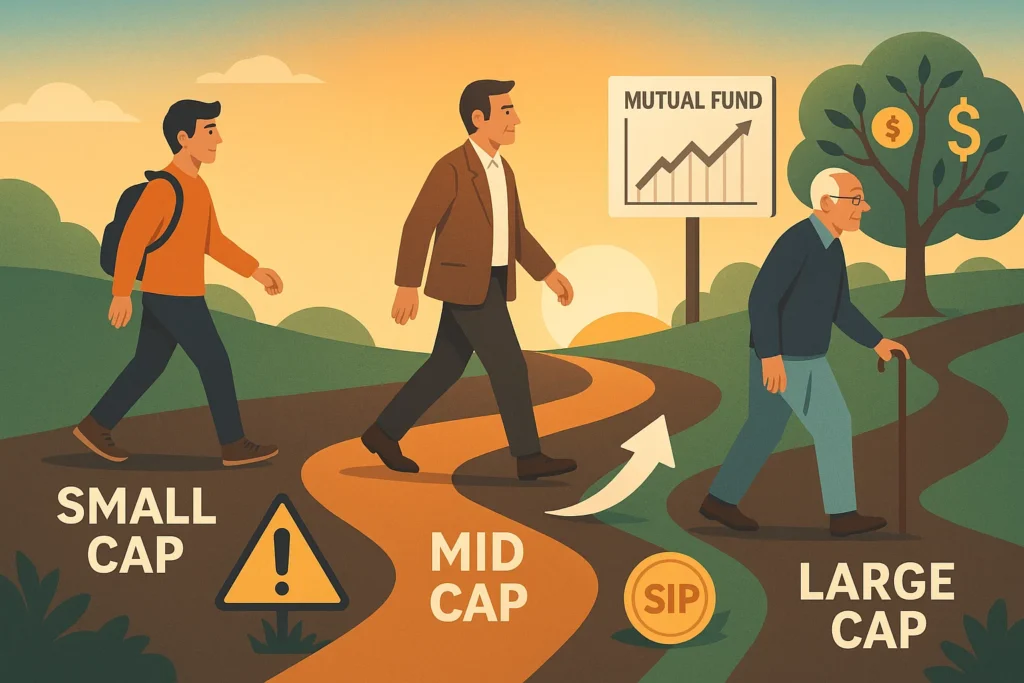Introduction: Choosing the Best Mutual Fund by Age
When it comes to investing in mutual funds, one of the most common dilemmas investors face is choosing between large cap, mid cap, and small cap funds. Each category offers a different risk-return profile, and selecting the right one depends largely on your investment horizon, risk appetite, and most importantly—your age.
The best mutual fund by age is not a one-size-fits-all solution. Young investors may lean toward high-growth opportunities, while retirees prioritize capital preservation. Understanding which type of mutual fund aligns with your life stage can help you build a portfolio that grows steadily while staying within your comfort zone.
In this blog, we break down the core differences between large, mid, and small cap mutual funds, and guide you on how to pick the right one based on your age and financial goals.
Understanding the Fund Types: Large Cap, Mid Cap, and Small Cap
Before identifying the best mutual fund by age, it’s important to understand the core differences between the three main categories of equity mutual funds. These are classified based on the market capitalization of the companies they invest in.
Large Cap Mutual Funds
These funds invest in the top 100 listed companies by market capitalization—well-established, financially sound businesses with proven track records.
Why choose large cap funds?
– Lower volatility compared to others
– More predictable returns over time
– Ideal for conservative or risk-averse investors
– Suitable for short- to medium-term financial goals
Mid Cap Mutual Funds
Mid cap funds invest in companies ranked 101 to 250 on the stock exchange by market capitalization. These firms are typically in a growth phase.
Why choose mid cap funds?
– Offer a balance between risk and return
– Higher growth potential than large caps
– Suitable for investors with a moderate risk appetite
– Ideal for medium- to long-term goals
Small Cap Mutual Funds
These funds focus on companies ranked beyond the top 250. While these firms offer immense growth potential, they also come with high volatility.
Why choose small cap funds?
– Potential for substantial long-term returns
– Suitable for investors with a high risk appetite
– Best for long investment horizons and wealth building
Understanding these fund types helps in aligning your investment with your financial goals and risk tolerance—especially when choosing the best mutual fund by age.
Large Cap vs Mid Cap vs Small Cap: Returns, Risks, and Volatility
To choose the best mutual fund by age, investors must understand how each category performs across key factors like stability, return potential, and suitability based on life stage. Here’s a detailed comparison:
| Feature | Large Cap Funds | Mid Cap Funds | Small Cap Funds |
|---|---|---|---|
| Market Coverage | Top 100 listed companies | Companies ranked 101–250 | Companies ranked 251+ |
| Stability | High | Medium | Low |
| Growth Potential | Moderate | High | Very High |
| Risk Level | Low | Moderate | High |
| Volatility | Low | Medium | High |
| Minimum Investment Horizon | 3+ Years | 5+ Years | 7–10 Years |
| Return Expectation (5–10 yrs) | ~10–12% p.a. | ~12–15% p.a. | ~14–18%+ p.a. |
| Ideal For | Conservative, older investors | Balanced risk takers, mid-career | Aggressive young investors |
| Suitability by Age | 45+ years | 30–45 years | 20–30 years |
This comparison makes it easier to determine the best mutual fund by age, aligning your investment with both your current life stage and future financial goals.
Best Mutual Fund Type Based on Age
Choosing the best mutual fund by age is essential for building a portfolio that supports your evolving financial needs. Your risk tolerance, time horizon, and life responsibilities change as you age—and so should your investment strategy.
Here’s a breakdown of which fund types best suit each age group:
🔹 Age 20–30: Maximize Growth, Embrace Risk
At this stage, you have time on your side. You can afford to take more risks for potentially higher returns.
Recommended Fund Types:
– Small Cap Funds for aggressive long-term growth
– Mid Cap Funds to balance return potential
– Consider starting a SIP to build wealth over time
Why?
Your investment horizon is long (10+ years), and short-term market fluctuations won’t hurt your long-term goals.
🔹 Age 30–45: Growth with Stability
As career and family responsibilities increase, you still want growth—but with more controlled risk.
Recommended Fund Types:
– Mid Cap Funds for strong returns
– Large Cap Funds to add stability
– Flexi-Cap or Multi-Cap Funds for diversification
Why?
You need to balance wealth creation with financial planning for home, children, or future education expenses.
🔹 Age 45–60: Capital Preservation with Moderate Growth
This is the time to shift towards safer investments without completely giving up on returns.
Recommended Fund Types:
– Large Cap Funds for steady performance
– Balanced Advantage Funds or Hybrid Funds for smoother volatility
– Gradual reduction in mid or small caps
Why?
With retirement nearing, protecting capital becomes important, but inflation-beating growth is still needed.
🔹 Age 60 and Above: Income and Safety First
Post-retirement, your focus shifts to income and capital preservation.
Recommended Fund Types:
– Large Cap Funds for reliable performance
– Conservative Hybrid Funds with debt exposure
– Consider SWP (Systematic Withdrawal Plans) for regular income
Why?
At this stage, minimizing risk and ensuring liquidity is the priority. Equities can still play a small role, but cautiously.
By aligning fund choice with age, you ensure your investments stay relevant to your financial goals and life circumstances—making it easier to pick the best mutual fund by age with confidence.
Best Mutual Funds in Each Category (2025)
| Category | Recommended Fund | 3-Year CAGR | Fund Highlights |
|---|---|---|---|
| Large Cap | Axis Bluechip Fund | ~12.8% | Stable performer, focuses on quality blue-chip stocks |
| ICICI Prudential Bluechip Fund | ~13.1% | Strong track record, large AUM, good downside protection | |
| Mid Cap | Kotak Emerging Equity Fund | ~18.5% | Strong long-term growth, solid research strategy |
| PGIM India Midcap Opportunities Fund | ~19.2% | High alpha generator, aggressive style | |
| Small Cap | SBI Small Cap Fund | ~21.4% | Consistent outperformance, ideal for long-term wealth |
| Nippon India Small Cap Fund | ~22.0% | High risk-reward, deep small-cap exposure | |
| Flexi-Cap | Parag Parikh Flexi Cap Fund | ~15.3% | Global allocation, quality-driven approach |
| Hybrid (Balanced) | HDFC Balanced Advantage Fund | ~11.7% | Dynamic asset allocation, lower volatility |
| Conservative Hybrid | ICICI Prudential Regular Savings Fund | ~8.2% | Suitable for post-retirement income + low risk |
Note: Returns are approximate based on trailing 3-year performance. Investors should verify updated NAV and holdings on official AMC websites before investing.
Final Verdict – Which Is the Best Mutual Fund by Age?
There is no universal “best” mutual fund—because the right choice depends on you. Your age, goals, and risk tolerance all shape the ideal mutual fund strategy.
In your 20s and 30s, taking bold steps with mid cap and small cap funds can pay off over the long term. As you move into your 40s and 50s, shifting towards large cap and hybrid funds helps reduce risk while maintaining growth. For seniors, prioritizing capital protection and stable income becomes key—and that’s where large cap and conservative hybrid funds shine.
The smart approach is not about chasing the highest returns—but building a strategy that evolves with you. Whether you’re just starting your investment journey or approaching retirement, selecting the best mutual fund by age ensures your money works harder, smarter, and safer—exactly when you need it to.
FAQs – Best Mutual Fund by Age
- What is the best mutual fund for someone in their 20s?
Small cap or mid cap funds are ideal for long-term growth in your 20s due to higher risk tolerance. - Which mutual fund is safest for senior citizens?
Large cap or conservative hybrid funds offer lower risk and steady income, suitable for retirees. - Can I switch from small cap to large cap as I age?
Yes, rebalancing your portfolio over time based on age and risk profile is a smart strategy. - Are large cap funds good for long-term goals?
Yes, they offer stability and consistent returns, making them suitable for conservative long-term goals. - How do I choose a mutual fund based on age?
Match your fund’s risk profile with your life stage—aggressive early on, conservative near retirement. - Is it safe to invest in small cap funds in your 40s?
Small cap funds carry higher risk; in your 40s, it’s better to focus more on mid and large caps. - Which fund is best for a balanced investment approach?
Flexi-cap and balanced advantage funds offer a mix of growth and stability. - Should I stop equity mutual fund SIPs after retirement?
Not necessarily. You can shift to conservative funds and use SWP for regular income. - What’s the ideal investment horizon for small cap funds?
At least 7–10 years, due to high volatility and long-term compounding potential. - Can I invest in multiple fund categories at once?
Yes, diversifying across categories helps balance risk and improve returns over time.
Related Articles:
New Algo Trading Rules– What Retail Traders Must Know
Algo Trading: A Beginner’s Guide to the Future of Investing
Intraday Trading Strategies: Tips for Beginners and Experts
More Articles
How to Transfer Shares from Groww to Zerodha – Full Guide (2025)
Dark Pool Trading: The Hidden World of Institutional Investing
SEBI vs Jane Street: Inside India’s ₹36,500 Cr Derivatives Manipulation Scandal






